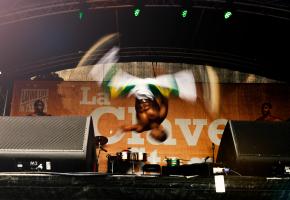1. RELIGION. Perhaps the strangest aspect of these fiestas, especially when become acquainted with their weird formalities, is that the majority of these tributes to excess are actually religious. Even the most serious of festivals seem to end in revelry. One minute the sombre ‘Semana Santa’ procession is carrying an effigy of Jesus on the through the streets amongst floods of tears, shedded in their masses in reverence. The next, this clearly traditionally Catholic, practice results in the closure of all public places to allow for excessive drinking and dancing in the name of the religion’s various saints.
2. SUPERSTITION/PAGANISM. If the majority of said fiestas take place in the name of catholic saints, there are also an abundance of festivals based on paganism and superstitions. The ‘Fiesta de Santa Marta de Ribarteme,’ takes place every July in Las Nieves in Galicia. Often described as one of the most outrageous religious pilgrimages in the world, this festival is one of the Church’s attempts to adapt its dogma to the region’s more primitive beliefs, with, I am sure you will agree, incredibly strange results. Indeed, this fiesta, whilst honouring Saint Marta de Ribarteme, the patron of resurrection, celebrates those who have managed to cheat death in the previous year by placing them in coffins and parading them through the town.
3. DEATH. Indeed, whether religious or not, death plays a central role in most of these celebrations. Mmm...Cheery. Yet don't think that these fiestas are a sombre affair. Nooo...who can forget the 'Burial of the Sardine' fiesta held in Madrid and various other locations on Ash Wednesday every year, during which revellers in fancy dress costumes attend the funeral of a sardine, be this a real sardine in a coffin or a plastic or cardboard effigy. Long live the fish!
4. BULLS. One cannot mention Spanish fiestas without mentioning bulls, albeit often for all the wrong reasons. Whether chased through the streets in an ‘encierro’ (bullrun,) or fought to death in a ‘corrida’ (bullfight,) a Spanish fiesta without bulls and their torment are rare. Make of the weird juxtaposition between the bull’s simultaneous VIP status and victim of torture what you will; it is something that troubles both foreigners and many Spaniards alike.
5. THE TORTURE GOES ON…. Bulls are not the only animals to suffer during such festivities however. During the ‘Fiesta de los Gansos,’ in Lekeitio a dead goose is hung over the harbour while men jump to catch hold of it, trying to see who can hold on for the longest. Seems harsh? Well, before animal right activists had their say, this goose was actually alive. Equally, if not more cruel, is the tradition of tossing a goat from a bell tower in Manganeses de la Polverosa. I kid you not. Although the event was outlawed by the Town Council in 1992, it was said that what people do in their own time is their own business and rumour has it that this somewhat macabre practice still continues.
6. THROWING THINGS. Spaniards don’t limit their evident fixation for throwing things to goats, and indeed fiestas see other animals, including ants and dead rats, thrown through the streets. Thrown yet? Such an obsession doesn’t stop there. Be it tomatoes, during ‘la Tomatina’ in Buñol, wine, during the ‘Haro’ festival in la Rioja, flour and eggs, during ‘Els Enfarinats’ in Alicante, or grapes, during ‘La Raima’ in Pobla del Duc, it seems that, instead of the excessive consumption seen during most English festivities, the Spaniards would rather throw their delicacies at one another- an interesting diet.
7. FIRE. If throwing things seems a little dangerous, remember Spaniards do like to play with fire during their fiestas. ‘Las Fallas’ ( literally, ‘Fire’) in Valencia is a fiesta orientated completely around this element, with hundreds of effigies set alight by fireworks and burnt on enormous bonfires throughout the city. Catalonia does not shy away from the flame either. ‘Correfucs,’ (literally ‘fire runs,’) consist of a group of men who dress as devils and light fireworks, sometimes actually running through a tunnel of fireworks. Slightly more extreme than bonfire night…
8. SAFETY. Fire of course is not always dangerous though, according to Spaniards who seem to believe it can actually be important for safety too. During the ‘Hogueras’ in Granada & Jaen, people jump through bonfires to protect themselves from illness- an interesting alternative to stocking up on vitamins… Indeed, many Spanish fiestas actually focus on safety, albeit the Spanish way. For example, those who want to protect their babies from evil spirits (as you do) can find a different home remedy at the ‘El Colacho’ festival in Castillo de Murcia. Here, babies are laid on the ground whilst grown men dressed as devils jump over them. Arguably not the safest way of ‘protecting’ your children…
9. UGLINESS. If you are accustomed to dressing up and looking your best at a party then Spanish fiestas may not be for you. Indeed, one fiesta even awards the ugliest guest. As part of ‘La Semana grande’ festival in Bilbao comes ‘El Concurso de los feos,’ a face-pulling competition in which he who pulls the ugliest face wins. A nice substitute for prom queen.
10.MADNESS. Unpacked your suitcases yet? I will leave you with one final element, perhaps an element that I do not need to mention, but also undeniably the most important element of all Spanish fiestas. Madness. Do the Spaniards recognize such a characteristic of their festivities? One festival seems to. On the 28th of December in Cordoba ‘El Baile de los locos,’( yes, literally ‘The Dance of the Mad’) takes place, during which women are the protagonists of a mad dance that commemorates the day King Herod killed the baby boys in Nazareth. Yes, seemingly their madness is recognized. Yet as the celebration continues, with a local dressing up as a bear and going through the streets of the town accompanied by a trainer in order to enact the fight between man and nature, not a mention of madness is made. Surely this apparently ‘perfectly normal’ activity is madness in itself? I leave you to decide…

















